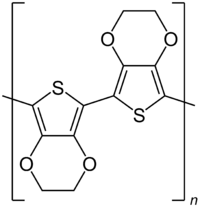Poly(3,4-ethylenedioxythiophene)
Poly(3,4-ethylenedioxythiophene) (PEDOT or PEDT; IUPAC name poly(2,3-dihydrothieno[3,4-b][1,4]dioxane-5,7-diyl)) is a conducting polymer based on 3,4-ethylenedioxythiophene or EDOT. It was reported in 1991.[1]

Polymer
Advantages of this polymer are optical transparency in its conducting state, high stability and moderate band gap and low redox potential. A large disadvantage is poor solubility, which is partly circumvented in the PEDOT:PSS composite, and the PEDOT-TMA material. Applications of PEDOT include electrochromic displays, antistatics, photovoltaics, electroluminescent displays, printed wiring, and sensors.[2][3]
The polymer is generated by oxidation. This process begins with production of the radical cation of EDOT monomer, [C2H4O2C4H2S]+. This cation attacks a neutral EDOT followed by deprotonation. The idealized conversion using peroxydisulfate is shown
- n C2H4O2C4H2S + n (OSO3)22− → [C2H4O2C4S]n + 2n HOSO3−
For commercial purposes, the polymerization is conducted in the presence of polystyrene sulfonate (PSS).[3] The resulting composites, PEDOT coatings are deposited on a conductive support (platinum, gold, glassy carbon, indium tin oxide, etc.) in organic solvents or in aqueous suspensions.
Uses
Pedot has been proposed for use in biocompatible interfaces.[4][5]
Further reading
- Bello, A; Giannetto, M; Mori, G; Seeber, R; Terzi, F; Zanardi, C (2007). "Optimization of the DPV potential waveform for determination of ascorbic acid on PEDOT-modified electrodes". Sensors and Actuators B: Chemical. 121 (2): 430. doi:10.1016/j.snb.2006.04.066. hdl:11380/621556.
- Kumar, S. Senthil; Mathiyarasu, J.; Phani, K. L. N.; Yegnaraman, V. (2005). "Simultaneous determination of dopamine and ascorbic acid on poly (3,4-ethylenedioxythiophene) modified glassy carbon electrode". Journal of Solid State Electrochemistry. 10 (11): 905. doi:10.1007/s10008-005-0041-7.</ref>
- Zhang, Xinyu; MacDiarmid, Alan G.; Manohar, Sanjeev K. (2005). "Chemical synthesis of PEDOT nanofibers". Chemical Communications (42): 5328–30. doi:10.1039/b511290g. PMID 16244744.</ref>
References
- F. Jonas, L. Schrader. "Conductive Modifications of Polymers with Polypyrroles and Polythiophenes". Synthetic Metals. 41: 831–836. doi:10.1016/0379-6779(91)91506-6.CS1 maint: uses authors parameter (link)
- Groenendaal, L. B.; Jonas, F.; Freitag, D.; Pielartzik, H.; Reynolds, J. R. (2000). "Poly(3,4-Ethylenedioxythiophene) and Its Derivatives: Past, Present, and Future". Adv. Mater. 12: 481–494. doi:10.1002/(SICI)1521-4095(200004)12:7<481::AID-ADMA481>3.0.CO;2-C.CS1 maint: uses authors parameter (link)
- Kirchmeyer, S.; Reuter, K. (2005). "Scientific Importance, Properties and Growing Applications of Poly(3,4-Ethylenedioxythiophene)". J. Mater. Chem. 15: 2077–2088. doi:10.1039/b417803n.CS1 maint: uses authors parameter (link)
- Donahue, Mary J.; Sanchez-Sanchez, Ana; Inal, Sahika; Qu, Jing; Owens, Roisin M.; Mecerreyes, David; Malliaras, George G.; Martin, David C. (1 April 2020). "Tailoring PEDOT properties for applications in bioelectronics". Materials Science and Engineering: R: Reports. 140: 100546. doi:10.1016/j.mser.2020.100546. ISSN 0927-796X.
- Cuthbertson, Anthony (17 August 2020). "Material found by scientists 'could merge AI with human brain'". The Independent.